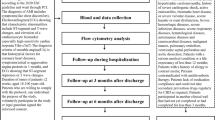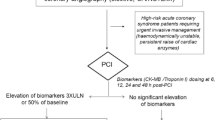Abstract
Background
Cardiac troponins provide excellent risk stratification in unstable angina (UA), but no reliable markers are available in troponin-negative patients. Beta2-integrin mediated T cell recruitment plays a pivotal role in coronary atherosclerotic plaque rupture. The present study investigates beta2-integrin activation on T cell subsets as a risk marker in UA.
Methods
Functional activation (affinity/avidity) of beta2-integrins on T cells was measured using a flow cytometry-based whole blood assay in 87 patients with UA.
Results
Beta2-integrin activation was significantly higher in patients with severe coronary artery disease (sC) and myocardial infarction (MI) compared to patients with no/minimal coronary atherosclerosis (no/mC), irrespective of troponin status. Adjusted for cardiovascular risk factors, medication, left ventricular function, MI at enrollment and high sensitivity C-reactive protein (hsCRP), beta2-integrin activation was independently associated with incidence of revascularization, hospitalization and all major cardiovascular events during 9 months of follow-up after index investigation. The highest prognostic value of beta2-integrin activation was seen in troponin-and hsCRP-negative patients.
Conclusion
Quantitative assessment of T cell beta2-integrin activation allows to identify high risk patients with UA and sC without established MI; furthermore, it is associated with incidence of future cardiovascular events independent of conventional risk factors (troponin, hsCRP).



Similar content being viewed by others
References
The Joint European Society of Cardiology/American College of Cardiology Committee (2000) Myocardial infarction redefined—a consensus document of The Joint European Society of Cardiology/American College of Cardiology Committee for the redefinition of myocardial infarction. Eur Heart J 21:1502–1513
Ahmed WH, Bittl JA, Braunwald E (1993) Relation between clinical presentation and angiographic findings in unstable angina pectoris, and comparison with that in stable angina. Am J Cardiol 72:544–550
Amyes E, McMichael AJ, Callan MF (2005) Human CD4+ T cells are predominantly distributed among six phenotypically and functionally distinct subsets. J Immunol 175:5765–5773
Banerjee S, Brilakis E, Zhang S, Roesle M, Lindsey J, Philips B, Blewett CG, Terada LS (2006) Endothelial progenitor cell mobilization after percutaneous coronary intervention. Atherosclerosis 189:70–75
Bose D, von Birgelen C, Zhou XY, Schmermund A, Philipp S, Sack S, Konorza T, Mohlenkamp S, Leineweber K, Kleinbongard P, Wijns W, Heusch G, Erbel R (2008) Impact of atherosclerotic plaque composition on coronary microembolization during percutaneous coronary interventions. Basic Res Cardiol 103:587–597
Braunwald E, Antman EM, Beasley JW, Califf RM, Cheitlin MD, Hochman JS, Jones RH, Kereiakes D, Kupersmith J, Levin TN, Pepine CJ, Schaeffer JW, Smith EE, 3rd, Steward DE, Theroux P, Gibbons RJ, Alpert JS, Eagle KA, Faxon DP, Fuster V, Gardner TJ, Gregoratos G, Russell RO, Smith SC, Jr. (2000) ACC/AHA guidelines for the management of patients with unstable angina and non-ST-segment elevation myocardial infarction: executive summary and recommendations: a report of the American College of Cardiology/American Heart Association task force on practice guidelines (committee on the management of patients with unstable angina). Circulation 102:1193–1209
de Lemos JA, Morrow DA, Blazing MA, Jarolim P, Wiviott SD, Sabatine MS, Califf RM, Braunwald E (2007) Serial measurement of monocyte chemoattractant protein-1 after acute coronary syndromes: results from the A to Z trial. J Am Coll Cardiol 50:2117–2124
De Palma R, Del Galdo F, Abbate G, Chiariello M, Calabro R, Forte L, Cimmino G, Papa MF, Russo MG, Ambrosio G, Giombolini C, Tritto I, Notaristefano S, Berrino L, Rossi F, Golino P (2006) Patients with acute coronary syndrome show oligoclonal T cell recruitment within unstable plaque: evidence for a local, intracoronary immunologic mechanism. Circulation 113:640–646
Dustin ML, Springer TA (1989) T cell receptor crosslinking transiently stimulates adhesiveness through LFA-1. Nature 341:619–624
Erbel C, Sato K, Meyer FB, Kopecky SL, Frye RL, Goronzy JJ, Weyand CM (2007) Functional profile of activated dendritic cells in unstable atherosclerotic plaque. Basic Res Cardiol 102:123–132
Hamm CW, Ravkilde J, Gerhardt W, Jorgensen P, Peheim E, Ljungdahl L, Goldmann B, Katus HA (1992) The prognostic value of serum troponin T in unstable angina. N Engl J Med 327:146–150
Hansson GK (2001) Immune mechanisms in atherosclerosis. Arterioscler Thromb Vasc Biol 21:1876–1890
Hansson GK (2005) Inflammation, atherosclerosis, and coronary artery disease. N Engl J Med 352:1685–1695
Heeschen C, Dimmeler S, Hamm CW, van den Brand MJ, Boersma E, Zeiher AM, Simoons ML (2003) Soluble CD40 ligand in acute coronary syndromes. N Engl J Med 348:1104–1111
Heeschen C, Hamm CW, Bruemmer J, Simoons ML (2000) Predictive value of C-reactive protein and troponin T in patients with unstable angina: a comparative analysis. CAPTURE Investigators: chimeric c7E3 AntiPlatelet Therapy in unstable angina refractory to standard treatment trial. J Am Coll Cardiol 35:1535–1542
Herrmann J, Haude M, Lerman A, Schulz R, Volbracht L, Ge J, Schmermund A, Wieneke H, von Birgelen C, Eggebrecht H, Baumgart D, Heusch G, Erbel R (2001) Abnormal coronary flow velocity reserve after coronary intervention is associated with cardiac marker elevation. Circulation 103: 2339–2345
Herrmann J, Lerman A, Baumgart D, Volbracht L, Schulz R, von Birgelen C, Haude M, Heusch G, Erbel R (2002) Preprocedural statin medication reduces the extent of periprocedural non-Q-wave myocardial infarction. Circulation 106:2180–2183
Hogg N, Henderson R, Leitinger B, McDowall A, Porter J, Stanley P (2002) Mechanisms contributing to the activity of integrins on leukocytes. Immunol Rev 186:164–171
Katus HA, Remppis A, Neumann FJ, Scheffold T, Diederich KW, Vinar G, Noe A, Matern G, Kuebler W (1991) Diagnostic efficiency of troponin T measurements in acute myocardial infarction. Circulation 83:902–912
Kavsak PA, Ko DT, Newman AM, Palomaki GE, Lustig V, Macrae AR, Jaffe AS (2007) Risk stratification for heart failure and death in an acute coronary syndrome population using inflammatory cytokines and N-Terminal pro-brain natriuretic peptide. Clin Chem 53:2112–2118
Kinashi T (2005) Intracellular signalling controlling integrin activation in lymphocytes. Nat Rev Immunol 5:546–559
Konstandin MH, Sester U, Klemke M, Weschenfelder T, Wabnitz GH, Samstag Y (2006) A novel flow-cytometry-based assay for quantification of affinity and avidity changes of integrins. J Immunol Methods 310:67–77
Konstandin MH, Wabnitz GH, Aksoy H, Kirchgessner H, Dengler TJ, Samstag Y (2007) A sensitive assay for the quantification of integrin-mediated adhesiveness of human stem cells and leukocyte subpopulations in whole blood. J Immunol Methods 327:30–39
Korff S, Katus HA, Giannitsis E (2006) Differential diagnosis of elevated troponins. Heart 92:987–993
Libby P, Ridker PM, Maseri A (2002) Inflammation and atherosclerosis. Circulation 105:1135–1143
Lindahl B, Toss H, Siegbahn A, Venge P, Wallentin L (2000) Markers of myocardial damage and inflammation in relation to long-term mortality in unstable coronary artery disease: FRISC Study Group. Fragmin during instability in coronary artery disease. N Engl J Med 343:1139–1147
Liuzzo G, Biasucci LM, Trotta G, Brugaletta S, Pinnelli M, Digianuario G, Rizzello V, Rebuzzi AG, Rumi C, Maseri A, Crea F (2007) Unusual CD4+ CD28null T lymphocytes and recurrence of acute coronary events. J Am Coll Cardiol 50:1450–1458
Liuzzo G, Goronzy JJ, Yang H, Kopecky SL, Holmes DR, Frye RL, Weyand CM (2000) Monoclonal T cell proliferation and plaque instability in acute coronary syndromes. Circulation 101:2883–2888
Liuzzo G, Kopecky SL, Frye RL, O’Fallon WM, Maseri A, Goronzy JJ, Weyand CM (1999) Perturbation of the T cell repertoire in patients with unstable angina. Circulation 100:2135–2139
Lloyd AR, Oppenheim JJ, Kelvin DJ, Taub DD (1996) Chemokines regulate T cell adherence to recombinant adhesion molecules and extracellular matrix proteins. J Immunol 156:932–938
Luscher MS, Thygesen K, Ravkilde J, Heickendorff L (1997) Applicability of cardiac troponin T and I for early risk stratification in unstable coronary artery disease. TRIM Study Group. Thrombin inhibition in myocardial ischemia. Circulation 96:2578–2585
Morrow DA, Antman EM, Tanasijevic M, Rifai N, de Lemos JA, McCabe CH, Cannon CP, Braunwald E (2000) Cardiac troponin I for stratification of early outcomes and the efficacy of enoxaparin in unstable angina: a TIMI-11B substudy. J Am Coll Cardiol 36:1812–1817
Morrow DA, Rifai N, Antman EM, Weiner DL, McCabe CH, Cannon CP, Braunwald E (1998) C-reactive protein is a potent predictor of mortality independently of and in combination with troponin T in acute coronary syndromes: a TIMI 11A substudy. thrombolysis in myocardial infarction. J Am Coll Cardiol 31:1460–1465
Neri Serneri GG, Prisco D, Martini F, Gori AM, Brunelli T, Poggesi L, Rostagno C, Gensini GF, Abbate R (1997) Acute T cell activation is detectable in unstable angina. Circulation 95:1806–1812
Ross R (1999) Atherosclerosis—an inflammatory disease. N Engl J Med 340:115–126
Silber S, Hoffmeister HM, Drexler C, Schachinger V, Kuon E (2006) Working instructions in the cardiac catheter laboratory. According to paragraph 18 (2): radiographic regulation for a radiography facility for the use of x-rays with humans as a model. Clin Res Cardiol 95 Suppl 4:72–75
Spagnoli LG, Bonanno E, Mauriello A, Palmieri G, Partenzi A, Sangiorgi G, Crea F (2002) Multicentric inflammation in epicardial coronary arteries of patients dying of acute myocardial infarction. J Am Coll Cardiol 40:1579–1588
Springer TA (1994) Traffic signals for lymphocyte recirculation and leukocyte emigration: the multistep paradigm. Cell 76:301–314
Stemme S, Faber B, Holm J, Wiklund O, Witztum JL, Hansson GK (1995) T lymphocytes from human atherosclerotic plaques recognize oxidized low density lipoprotein. Proc Natl Acad Sci USA 92:3893–3897
Stewart M, Hogg N (1996) Regulation of leukocyte integrin function: affinity vs. avidity. J Cell Biochem 61:554–561
Thygesen K, Alpert JS, White HD, Jaffe AS, Apple FS, Galvani M, Katus HA, Newby LK, Ravkilde J, Chaitman B, Clemmensen PM, Dellborg M, Hod H, Porela P, Underwood R, Bax JJ, Beller GA, Bonow R, Van der Wall EE, Bassand JP, Wijns W, Ferguson TB, Steg PG, Uretsky BF, Williams DO, Armstrong PW, Antman EM, Fox KA, Hamm CW, Ohman EM, Simoons ML, Poole-Wilson PA, Gurfinkel EP, Lopez-Sendon JL, Pais P, Mendis S, Zhu JR, Wallentin LC, Fernandez-Aviles F, Fox KM, Parkhomenko AN, Priori SG, Tendera M, Voipio-Pulkki LM, Vahanian A, Camm AJ, De Caterina R, Dean V, Dickstein K, Filippatos G, Funck-Brentano C, Hellemans I, Kristensen SD, McGregor K, Sechtem U, Silber S, Tendera M, Widimsky P, Zamorano JL, Morais J, Brener S, Harrington R, Morrow D, Lim M, Martinez-Rios MA, Steinhubl S, Levine GN, Gibler WB, Goff D, Tubaro M, Dudek D, Al-Attar N (2007) Universal definition of myocardial infarction. Circulation 116:2634–2653
Valen G, Hinokiyama K, Vedin J, Vaage J (2007) Preoperative unstable angina causes venous adaptation to surgical graft injury. Basic Res Cardiol 102:265–273
van der Wal AC, Piek JJ, de Boer OJ, Koch KT, Teeling P, van der Loos CM, Becker AE (1998) Recent activation of the plaque immune response in coronary lesions underlying acute coronary syndromes. Heart 80:14–18
van Kooyk Y, van de Wiel-van Kemenade P, Weder P, Kuijpers TW, Figdor CG (1989) Enhancement of LFA-1-mediated cell adhesion by triggering through CD2 or CD3 on T lymphocytes. Nature 342:811–813
Weber C, Schober A, Zernecke A (2004) Chemokines: key regulators of mononuclear cell recruitment in atherosclerotic vascular disease. Arterioscler Thromb Vasc Biol 24:1997–2008
Zal B, Kaski JC, Arno G, Akiyu JP, Xu Q, Cole D, Whelan M, Russell N, Madrigal JA, Dodi IA, Baboonian C (2004) Heat-shock protein 60-reactive CD4+ CD28null T cells in patients with acute coronary syndromes. Circulation 109:1230–1235
Zernecke A, Weber C (2005) Inflammatory mediators in atherosclerotic vascular disease. Basic Res Cardiol 100:93–101
Conflict of interest
None declared.
Author information
Authors and Affiliations
Corresponding author
Additional information
Returned for 1. Revision: 15 October 2008 1. Revision received: 23 October 2008
Returned for 2. Revision: 30 October 2008 2. Revision received: 31 October 2008
Y. Samstag and T.J. Dengler contributed equally.
Electronic Supplementary material
Below is the link to the electronic supplementary material.
Rights and permissions
About this article
Cite this article
Konstandin, M.H., Aksoy, H., Wabnitz, G.H. et al. Beta2-integrin activation on T cell subsets is an independent prognostic factor in unstable angina pectoris. Basic Res Cardiol 104, 341–351 (2009). https://doi.org/10.1007/s00395-008-0770-8
Received:
Accepted:
Published:
Issue Date:
DOI: https://doi.org/10.1007/s00395-008-0770-8




